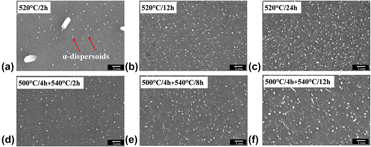Article contents
Precipitation behavior of dispersoids and elevated-temperature properties in Al–Si–Mg foundry alloy with Mo addition
Published online by Cambridge University Press: 16 July 2019
Abstract

In the present work, Mo was added to an Al–Si–Mg foundry alloy to study its influence on the evolution of dispersoids during various heat treatments. The microhardness and the elevated-temperature tensile properties and creep resistance were measured to evaluate the contribution of dispersoids. Results showed that the addition of Mo greatly promoted the formation of α-dispersoids. During solution treatment, the formation of α-dispersoids started after 8 h at 500 °C. At high temperature (540 °C), the coarsening of dispersoids with increasing time became predominant. The optimum condition of dispersoids can be reached by 520 °C/12 h or 500 °C/4 h + 540 °C/2 h, leading to the highest differences in microhardness between the Mo-containing alloy and base alloy. The tensile strengths were improved at both room temperature and elevated temperatures, while the elongation at elevated temperature was greatly increased. The creep resistance at elevated temperature is further enhanced due to the Mo addition.
Keywords
- Type
- Article
- Information
- Copyright
- Copyright © Materials Research Society 2019
References
- 10
- Cited by




